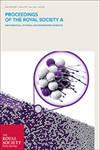非遍历叠加环境下的人类决策
IF 3
3区 综合性期刊
Q1 MULTIDISCIPLINARY SCIENCES
Proceedings of the Royal Society A: Mathematical, Physical and Engineering Sciences
Pub Date : 2023-10-01
DOI:10.1098/rspa.2023.0544
引用次数: 0
摘要
遍历性经济学对经济模型中遍历假设的有效性以及遍历性破坏对人类决策过程的影响提出了一个有趣的观点。先前的研究已经阐明了在乘法设置中遍历性打破的影响。然而,累加动力学中遍历性断裂的含义,特别是在具有“破产风险”或完全损失的情况下,仍未得到很大程度的探索。在我们的研究中,我们将“破产风险”的概念引入到我们的决策模型中,以检验非遍历性对加性动力学的影响。我们的理论框架和实验表明,在纯加性动力学中,人类决策者对非遍历性很敏感。这种敏感性表现为风险厌恶程度的显著不同,这取决于距离和相关的破产可能性。这些发现强调了时间平均值在人类决策中的关键作用,表明人类并不像植根于期望值的传统行为模型所假设的那样非理性。根据遍历性经济学的证据,结合非遍历性有可能阐明复合系统内决策的共同趋势,如乘法增长动力学。我们的研究强调了在存在破产风险时,在加性动态中理解决策模式的类似潜力。本文章由计算机程序翻译,如有差异,请以英文原文为准。
Human decision-making in a non-ergodic additive environment
Ergodicity Economics presents an intriguing perspective on the validity of the ergodic hypothesis within economic models and the influence of ergodicity breaking on human decision-making processes. Prior research has illuminated the impact of ergodicity breaking within multiplicative settings. However, the implications of ergodicity breaking within additive dynamics, especially in situations carrying a ‘risk of ruin’ or a complete loss, remain largely unexplored. In our research, we introduce the concept of ‘risk of ruin’ into our decision-making model to examine the effects of non-ergodicity in additive dynamics. Our theoretical framework and experiments show that human decision-makers are sensitive to non-ergodicity within purely additive dynamics. This sensitivity manifests itself in significantly different levels of risk aversion depending on the distance and associated likelihood of ruin. These findings underscore the critical role of time averages in human decision-making, suggesting that humans are less irrational than conventionally assumed in behavioural models rooted in expected values. Drawing on evidence from Ergodicity Economics, incorporating non-ergodicity has the potential to illuminate common trends in decision-making within compounding systems, like multiplicative growth dynamics. Our research underscores a similar potential for understanding decision-making patterns within additive dynamics when the risk of ruin is present.
求助全文
通过发布文献求助,成功后即可免费获取论文全文。
去求助
来源期刊
CiteScore
6.40
自引率
5.70%
发文量
227
审稿时长
3.0 months
期刊介绍:
Proceedings A has an illustrious history of publishing pioneering and influential research articles across the entire range of the physical and mathematical sciences. These have included Maxwell"s electromagnetic theory, the Braggs" first account of X-ray crystallography, Dirac"s relativistic theory of the electron, and Watson and Crick"s detailed description of the structure of DNA.

 求助内容:
求助内容: 应助结果提醒方式:
应助结果提醒方式:


